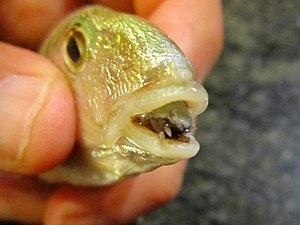
Back تطفل Arabic Parasitismu AST Parazitizm Azerbaijani انگل AZB Паразітызм Byelorussian Паразытызм BE-X-OLD Паразитизъм Bulgarian পরজীবিতা Bengali/Bangla Parazitizam BS Parasitisme Catalan

Parasitism is a close relationship between species, where one organism, the parasite, lives on or inside another organism, the host, causing it some harm, and is adapted structurally to this way of life.[1] The entomologist E. O. Wilson characterised parasites as "predators that eat prey in units of less than one".[2] Parasites include single-celled protozoans such as the agents of malaria, sleeping sickness, and amoebic dysentery; animals such as hookworms, lice, mosquitoes, and vampire bats; fungi such as honey fungus and the agents of ringworm; and plants such as mistletoe, dodder, and the broomrapes.
There are six major parasitic strategies of exploitation of animal hosts, namely parasitic castration, directly transmitted parasitism (by contact), trophically-transmitted parasitism (by being eaten), vector-transmitted parasitism, parasitoidism, and micropredation. One major axis of classification concerns invasiveness: an endoparasite lives inside the host's body; an ectoparasite lives outside, on the host's surface.
Like predation, parasitism is a type of consumer–resource interaction,[3] but unlike predators, parasites, with the exception of parasitoids, are much smaller than their hosts, do not kill them, and often live in or on their hosts for an extended period. Parasites of animals are highly specialised, each parasite species living on one given animal species, and reproduce at a faster rate than their hosts. Classic examples include interactions between vertebrate hosts and tapeworms, flukes, and those between the malaria-causing Plasmodium species, and fleas.
Parasites reduce host fitness by general or specialised pathology, that ranges from parasitic castration to modification of host behaviour. Parasites increase their own fitness by exploiting hosts for resources necessary for their survival, in particular by feeding on them and by using intermediate (secondary) hosts to assist in their transmission from one definitive (primary) host to another. Although parasitism is often unambiguous, it is part of a spectrum of interactions between species, grading via parasitoidism into predation, through evolution into mutualism, and in some fungi, shading into being saprophytic.
Human knowledge of parasites such as roundworms and tapeworms dates back to ancient Egypt, Greece, and Rome. In early modern times, Antonie van Leeuwenhoek observed Giardia lamblia with his microscope in 1681, while Francesco Redi described internal and external parasites including sheep liver fluke and ticks. Modern parasitology developed in the 19th century. In human culture, parasitism has negative connotations. These were exploited to satirical effect in Jonathan Swift's 1733 poem "On Poetry: A Rhapsody", comparing poets to hyperparasitical "vermin". In fiction, Bram Stoker's 1897 Gothic horror novel Dracula and its many later adaptations featured a blood-drinking parasite. Ridley Scott's 1979 film Alien was one of many works of science fiction to feature a parasitic alien species.[4]
- ^ Poulin 2007, pp. 4–5.
- ^ Cite error: The named reference
Wilson2014was invoked but never defined (see the help page). - ^ Getz, W. M. (2011). "Biomass transformation webs provide a unified approach to consumer-resource modelling". Ecology Letters. 14 (2): 113–124. Bibcode:2011EcolL..14..113G. doi:10.1111/j.1461-0248.2010.01566.x. PMC 3032891. PMID 21199247.
- ^ Cite error: The named reference
Guardian2009was invoked but never defined (see the help page).